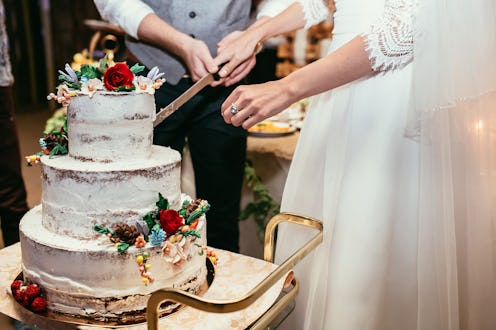
Few things are as iconic in our culture as the wedding cake — but although we usually have an incredibly specific image in mind when we think of the words “wedding cake,” this celebratory pastry hasn’t always looked the same. Mode’s video “100 Years of Wedding Cakes & Toppers” shows us how wedding cakes have evolved over the past century — and, in fact, it drives home just how much something seemingly “traditional” can change in a comparatively brief amount of time.
As my partner and I have worked on planning our own wedding this year, I’ve found one of the most useful things to keep in mind is the fact that weddings haven’t always been the big, huge to-dos we tend to think of them as being today — or perhaps more accurately, the big, huge to-dos the wedding industry would like us to think of them being today. As the excellent book A Practical Wedding: Creative Ideas for Planning a Beautiful, Affordable, and Meaningful Celebration points out, up until the mid-19th century (which, in the grand scheme of things, is actually quite recent), most weddings didn’t take place at elaborate venues or include a full, multi-course, catered, sit-down meal; they were typically small affairs held at home in which the happy couple wore the nicest outfits they already owned and finished the whole thing up with a simple cake-and-punch reception. The cake and punch, of course, were homemade, rather than outsourced to a bakery.
This, by the way, is one of the reasons I think arguments that pressure spouses-to-be to include all the trappings of the White Wedding “because it’s traditional” are BS; when you consider wedding history, a small, at-home celebration is far more traditional than what's considered the norm today.
In any event, though, the cake part of the punch-and-cake equation actually goes back quite a long way. According to the delightfully named article “Wedding Cake: A Slice of History” on the website Gastronomica: The Journal of Critical Food Studies, nuptial celebrations have included some sort of cake-type food since antiquity; in ancient Rome, for example, the culmination of a wedding involved smashing a cake made of wheat or barley over the bride’s head. (It was supposed to symbolize good fortune, although exactly how or why, I’m not totally sure.) By the mid-17th century in England, sugar was much more readily available; furthermore, there was a class element to it, too: Being able to afford white, refined sugar was a status symbol. So, wedding cakes made with it — and, specifically, frosted with it — became status symbols as well.
By the time we got to the beginning of the 20th century, weddings began resembling today's modern wedding. And as weddings grew more elaborate over time — and as the wedding industry became A Thing — the cakes, too, got bigger and fancier. Tiers were added, frosting designs became more dramatic, and toppers started to include miniature representations of the couple tying the knot. It’s how we get, as Mode’s video shows us, from point A in the 1910s to point B in the 2010s.
Here, let's take a quick look (you can watch the full video above):
1916
That’s it. Just a plainly frosted cake with flowers on top. Simple, yet elegant.
1946
Post-war, we’ve got multiple tiers, decor out the wazoo, and a tiny little statue of the happy couple up top. Note the horseshoes in the frosting — a symbol of good luck.
1976
The whole cake-tiers-on-stilts thing has always kind of confused me; it seems rather structurally unsound, and honestly, when you’re dealing with a huge (and usually expensive) piece of pastry, I don’t really know why you’d want to make it any more difficult for yourself than you need to. But that was the trend, so… when in Rome, I guess.
1986
This is what wedding cakes looked like when I was a kid. I usually wanted to use them as playgrounds for my Barbies and action figures.
2006
The early 2000s began to see a slight shift in tone: Cake toppers became humorous (if somewhat problematic — hi there, gender stereotypes!), and cupcakes and other alternatives entered the picture. Who doesn’t like having options?
Indeed, these days, pretty much anything goes. I remember reading an article in the New York Times circa 2011 about alternative ways people are approaching the wedding cake situation, and it stuck with me enough that, five years later, my first thought about the food at my own wedding wasn’t, “What should our wedding cake look like?”; rather, it was, “CAN WE HAVE WEDDING DOUGHNUTS?” My beef with standard wedding cakes is that they always look amazing… but honestly, I’ve never actually eaten one that tasted amazing, too. So wedding cake alternatives? That’s something I can get behind.
Like so many other things, though, wedding cakes are ultimately a “you do you” decision — so whether that’s a five-tiered masterpiece covered in fondant or a glazed doughnut tower, if it works for you, then that’s all that matters.